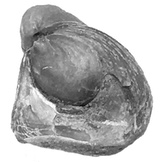Stacking Patterns and Parasequence Sets
Sedimentary cycles often display persistent trends in thickness and facies composition, called stacking patterns, and these fall into four types: retrogradational, aggradational, progradational, and degradational. Parasequences that show such trends are called parasequence sets. Depositional sequences can also show these trends, and they are called sequence sets. Early studies treated degradational as a type of progradational stacking, but many workers now recognize it as distinct.
Retrogradational Stacking
In a retrogradational set of parasequences, each parasequence is shifted landwards relative to the the preceding parasequence, which produces an overall deepening-upward trend. Retrogradational stacking is also commonly called backstepping.

Retrogradationally stacked parasequences, shown along depositional dip, with landward to the left, and seaward to the right. Adapted from Van Wagoner et al. (1990).
In a single outcrop, a retrogradational parasequence set can be recognized by the progressive appearance of deeper water facies upwards within the parasequence set, paralleled by a progressive loss of shallower water facies. For example, offshore facies might be present only in the uppermost parasequences, and shoreface facies might be present only in the lowermost parasequences.
In a cross-section, a retrogradational parasequence set can be recognized by the landward movement of a particular facies contact at an equivalent position in a parasequence. For example, the contact between the offshore transition and the shoreface at the top of each parasequence moves farther landward in each successive parasequence. Another way to describe this is that the trajectory of the shore over time is landward and upward.
Retrogradational stacking results when the long-term rate of accommodation exceeds the long-term rate of sedimentation. In this way, accommodation space is created more rapidly than it is filled, water depth becomes deeper, and facies increasingly move farther landward. Although each parasequence is shallowing-upward, the amount of deepening at the flooding surface exceeds the amount of shallowing in the following parasequence, producing a net overall deepening within the parasequence set.
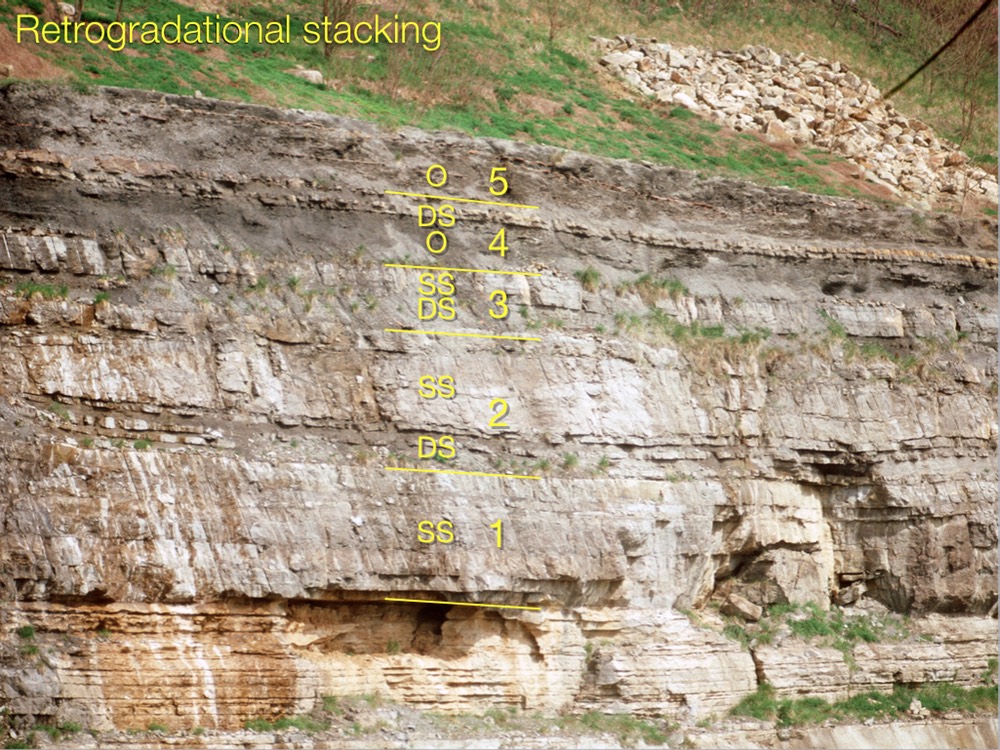
Five retrogradationally stacked parasequences with flooding surfaces indicated (yellow lines). SS: shallow subtidal, DS: deep subtidal, O: offshore. Mississippian Bangor Limestone, Monteagle, Tennessee.
Aggradational Stacking
In an aggradational set of parasequences, each parasequence is placed in roughly the same lateral position as the previous parasequence. As a result, there is no net vertical trend in water depth.

Aggradationally stacked parasequences, shown along depositional dip, with landward to the left, and seaward to the right. Adapted from Van Wagoner et al. (1990).
In a single outcrop, an aggradational parasequence set can be recognized by the similarity of facies composition in each successive parasequence. No new deeper or shallower water facies will tend to appear near the top or base of the parasequence set. For example, within any vertical column in the cross-section shown above, every parasequence contains the same set of facies in the same relative proportions.
In a cross-section, an aggradational parasequence set can be recognized by the relative stability of any particular facies contact at an equivalent position in a parasequence. For example, the contact between the offshore transition and shoreface at the top of each parasequence stays at roughly the same lateral position. Facies contacts rarely remain at precisely the same position, so aggradational stacking is used for any parasequence sets that display no clear long-term trend in the position of facies belts. Another way to describe this is that the trajectory of the shore over time is only upward, neither landward nor seaward.
Aggradational stacking results when the long-term rate of accommodation closely matches the long-term rate of sedimentation. In this way, accommodation space is filled about as rapidly as it is created, water depth remains constant from one parasequence to the next, and facies show no net landward or seaward movement. Although each parasequence is shallowing-upward and is bounded by a flooding surface, the shallowing in each parasequence closely balances the deepening at the underlying flooding surface, resulting in no net shift of facies from one parasequence to the next.
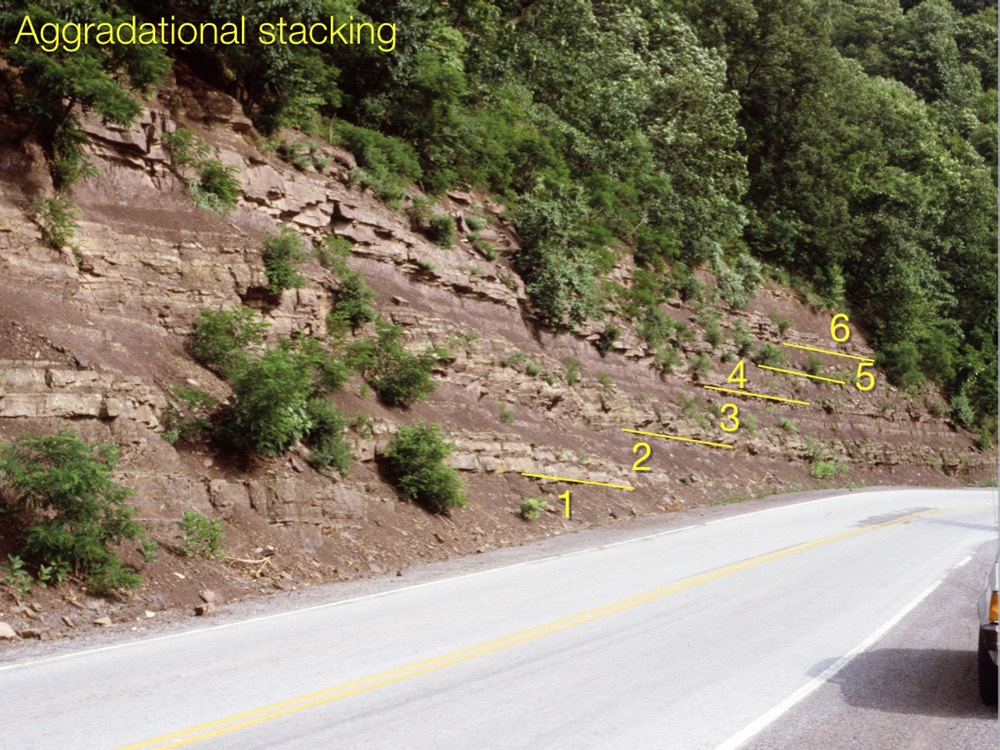
Aggradationally stacked parasequences developed on a tidal flat coastline. Each parasequence is upward fining from sand flat through mud flat facies. Note the similarity of each of the parasequences and the lack of a clear overall upward trend towards more sand flat or more mud flat facies. Upper Ordovician Juniata Formation, Germany Valley, West Virginia.
Progradational Stacking
In a progradational set of parasequences, each parasequence is placed in roughly the same lateral position as the previous parasequence. As a result, there is no net vertical trend in water depth.
In a progradational set of parasequences, each parasequence is shifted somewhat farther seaward than the parasequence before. This produces an overall shallowing-upward trend.

Progradationally stacked parasequences, shown along depositional dip, with landward to the left, and seaward to the right. Adapted from Van Wagoner et al. (1990).
In a single outcrop, a progradational parasequence set can be recognized by the progressive appearance of shallower-water facies upward in the parasequence set, matched by a progressive loss of deeper-water facies. For example, offshore facies may be present only in the lowest parasequences, and shoreface may be present only in the highest parasequences. Similarly, each successive parasequence will show a greater proportion of shallower-water facies.
In a cross-section, a progradational parasequence set can be recognized by the seaward movement of a particular facies contact at an equivalent position in a parasequence. For example, the contact between the offshore transition and shoreface at the top of each parasequence moves basinward through successive parasequences. For progradational stacking, the trajectory of the shore over time is seawards and upwards.
Progradational stacking results when the long-term rate of accommodation is exceeded by the long-term rate of sedimentation. In this way, accommodation space is filled more rapidly than it is created, water depth becomes shallower, and facies belts move farther seaward over time. Each parasequence is shallowing-upward and is bounded by a flooding surface, across which water depth abruptly increases. However, the shallowing gained in one parasequence exceeds any deepening across the underlying flooding surface, resulting in a net seaward movement of facies relative to the previous parasequence.
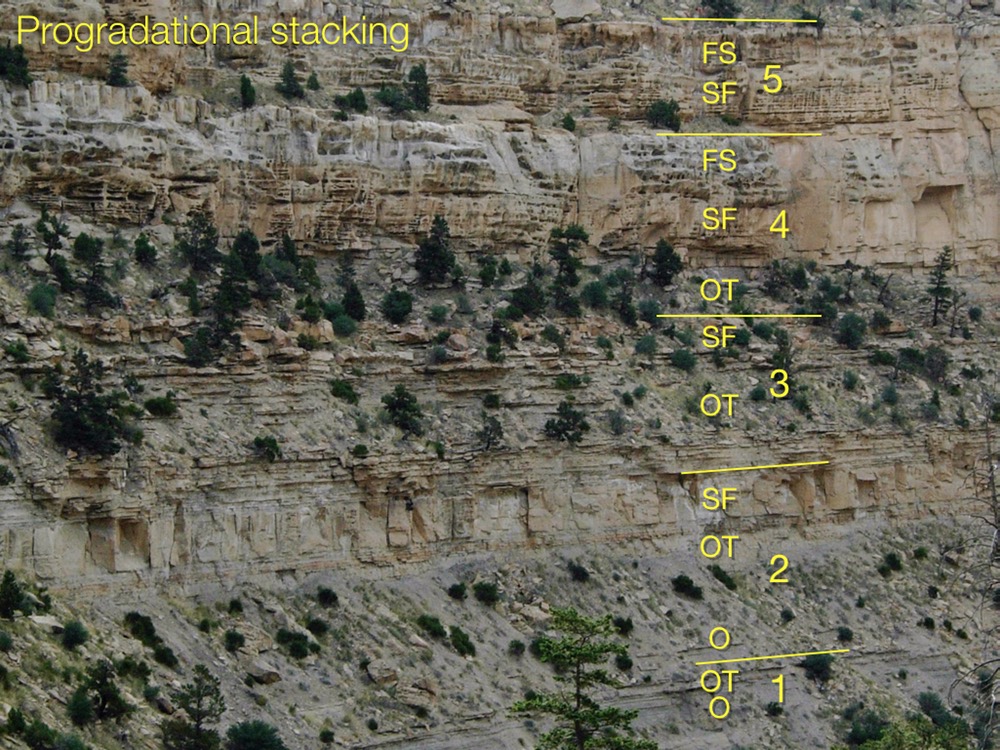
Progradationally stacked parasequences developed along a wave-dominated siliciclastic coastline. O: offshore, OT: offshore transition, SF: shoreface, FS: foreshore. Cretaceous Blackhawk Formation, Gentile Wash, Helper, Utah.
Degradational Stacking
In degradational stacking, each unit is shifted farther seaward (like progradational stacking) and downwards. For this to be possible, the boundaries between the units are not flooding surfaces, but the opposite: sharp contacts separating underlying deeper-water facies from overlying shallower-water facies. Such surfaces are called surfaces of forced regression. Like progradational stacking, degradational stacking produces net upward shallowing.

Degradational stacking, shown along depositional dip, with landward to the left, and seaward to the right.
In a single outcrop, degradational stacking can be recognized by packages being bounded by surfaces of forced regression rather than flooding surfaces. It is also characterized by net upward shallowing, but with the shallowing occurring over an unusually thin stratigraphic interval, in what is called a ‘telescoped’ section. Such telescoping often results in the complete absence of some facies, such as the lower shoreface.
In a cross-section, degradational stacking is recognized by the seaward and downward (that is, down the depositional slope) movement of a particular facies contact at an equivalent position in a parasequence. For example, the contact between the offshore transition and shoreface at the top of each unit moves basinward and downward through the set. In degradational stacking, the trajectory of the shore over time is seaward and downward, contrasted with progradational stacking where the trajectory is seaward and upward.
Degradational stacking results when the long-term rate of accommodation is negative, such that accommodation space is being lost, either through eustatic fall, tectonic uplift, or both.
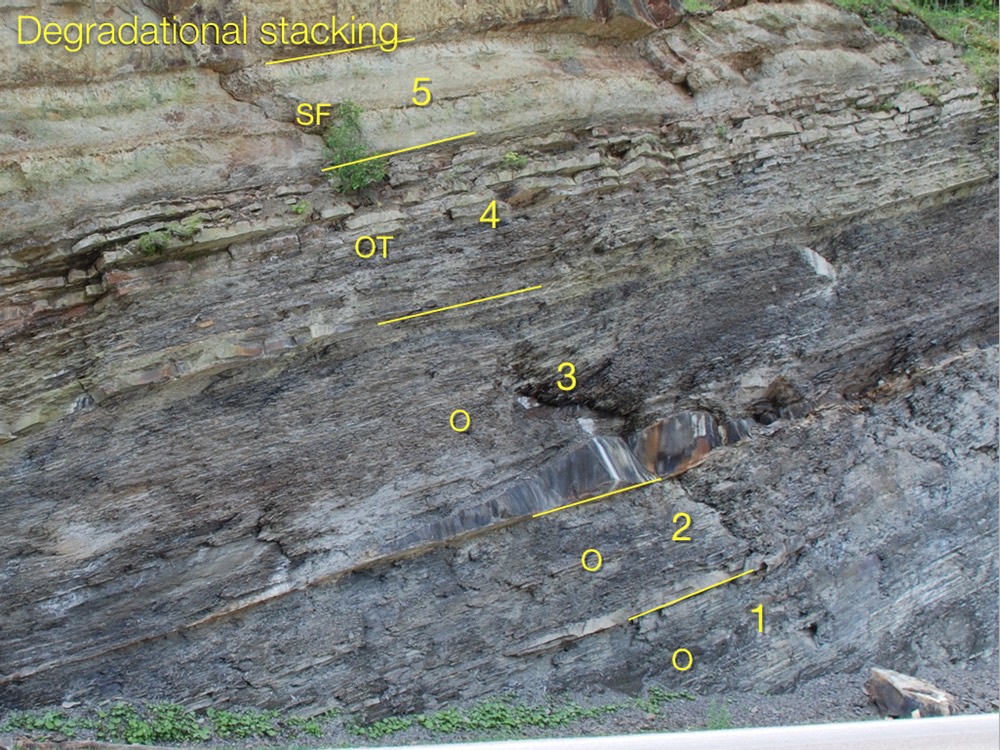
Degradational stacking developed along a wave-dominated siliciclastic coastline, with surfaces of forced regression shown in yellow. O: offshore, OT: offshore transition, SF: shoreface. Silurian Clinch Formation, Stickleyville, Virginia.
